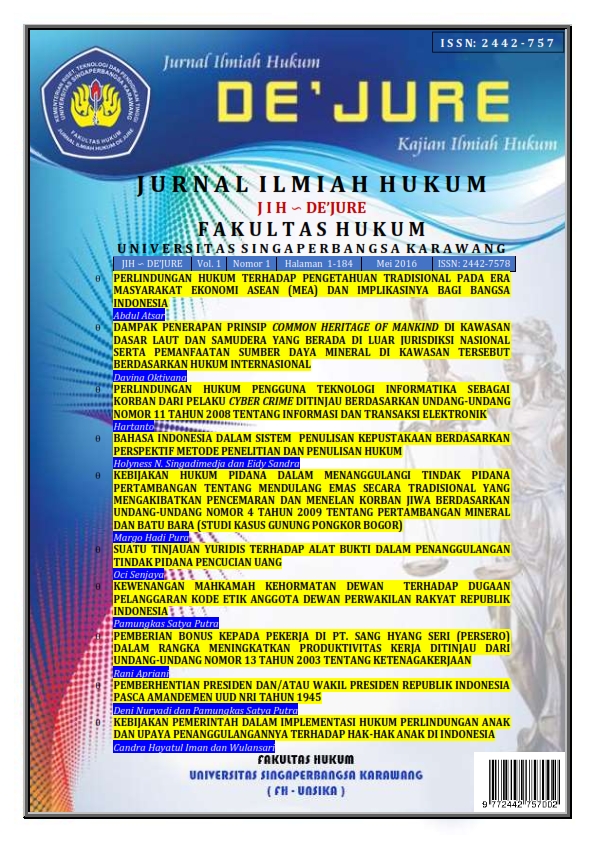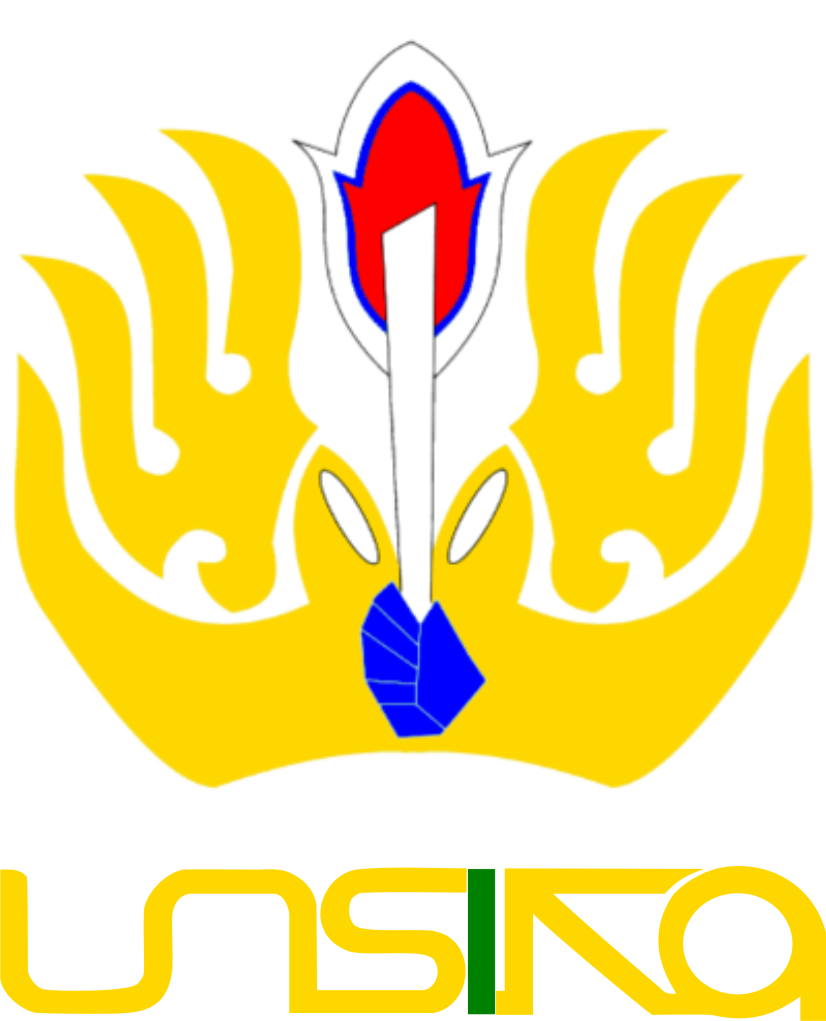DAMPAK PENERAPAN PRINSIP COMMON HERITAGE OF MANKIND DI KAWASAN DASAR LAUT DAN SAMUDERA YANG BERADA DI LUAR YURISDIKSI NASIONAL SERTA PEMANFAATAN SUMBER DAYA MINERAL DI KAWASAN TERSEBUT BERDASARKAN HUKUM
DOI:
https://doi.org/10.35706/dejure.v1i1.409Abstrak
ABSTRAK
Dasar laut dan dasar samudera diketahui sebagai lokasi di mana banyak ditemukan sumber non-hayati berupa batu-batuan yang kaya akan kandungan logam dan mineral. Konvensi Hukum Laut 1982 mengatur dasar laut dan samudera yang berada di luar yurisdiksi nasional atau disebut sebagai Kawasan, serta pemanfaatan sumber daya non-hayati khususnya sumber daya mineral dengan menerapkan prinsip common heritage of mankind. Seluruh aktivitas yang berkaitan dengan eksplorasi dan eksploitasi di Kawasan diatur oleh International Seabed Authority (ISBA). ISBA memiliki kewenangan dalam menentukan Negara atau perusahaan mana yang akan melakukan penambangan, lokasi mana yang dapat dilakukan penambangan, jangka waktu serta biaya yang ditetapkan. Dalam tulisan ini akan ditelusuri bagaimana aspek hukum konsep benefit for mankind dan benefit sharing dalam penerapan prinsip common heritage of mankind terhadap Kawasan dan sumber daya mineral yang terkandung di dalamnya, dimulai sejak kemunculannya dan perkembangan yang menyertainya, kemudian bagaimana aspek-aspek lain yang mempengaruhi penerapan prinsip tersebut. Terakhir, akan dijelaskan mengenai dampak terhadap perlindungan lingkungan laut yang muncul akibat kegiatan eksplorasi dan eksploitasi terhadap sumber daya mineral. Hasil penelitian menunjukkan bahwa penerapan prinsip common heritage of mankind melahirkan konsep benefit for mankind dan benefit sharing dalam kegiatan eksplorasi dan eksploitasi sumber daya mineral di Kawasan. Konsep benefit for mankind berarti semua negara tanpa terkecuali memiliki hak yang sama untuk melakukan kegiatan di Kawasan, sementara benefit sharing adalah pembagian keuntungan dari Negara-negara penambang yang di distribusikan secara merata kepada negara dengan status least-developed atau negara tidak berpantai (land-locked states). Terdapat pengaturan secara zonasi dan pembedaan spesies dalam upaya melakukan tindakan konservasi, serta pengaturan khusus mengenai pencemaran lingkungan laut oleh aktivitas penambangan di Kawasan berdasarkan KHL 1982, 1994 Agreement, The Mining Code (ISBA) maupun prinsip-prinsip yang berlaku berdasarkan hukum kebiasaan internasional.
Kata kunci: Common Heritage of Mankind, Kawasan Dasar Laut, Sumber Daya Mineral.
ABSTRACT
Seabed and ocean floor known as the site where many non-biological sources found in the form of rocks rich in metals and minerals. Convention on the Law of the Sea 1982 regulates the of oceans and seas which are beyond national jurisdiction or referred to as the Region, as well as the utilization of non-living resources, especially mineral resources by applying the principle of common heritage of mankind. All activities related to the exploration and exploitation in the area governed by the International Seabed Authority (ISBA). ISBA have the authority to determine the country or which company will do mine, which location do mining, as well as the time period a set fee. In this article will explore how the legal aspects of the concept of benefit for mankind and benefit sharing in the application of the principle of common heritage of mankind against the Region and mineral resources contained therein, starting from its origins and developments that accompany it, then what about the other aspects that affect the application of the principle. The last, in this article will explain the impact on the protection of the marine environment arising from the exploration and exploitation of mineral resources. The results showed that the application of the principle of common heritage of mankind gave birth to the concept of benefit for mankind and benefit sharing in the exploration and exploitation of mineral resources in the Area. The concept of benefit for mankind means all countries without exception have the same rights to perform activities in the Region, while benefit sharing is the sharing of benefits from countries miners were distributed evenly to the state or the status of least-developed countries are not locked (land-locked states). There are zoning regulation and differentiation of species in an effort to make conservation measures, as well as special arrangements regarding pollution of the marine environment by mining activities in the area based KHL 1982, 1994 Agreement, The Mining Code (ISBA) and the principles that apply under customary international law.
Keywords: Common Heritage of Mankind, Seabed Area, Mineral Resources.
Unduhan
Referensi
Agoes, Etty R. Konvensi Hukum Laut 1982: Masalah Pengaturan Hak Lintas Kapal Asing. Bandung: CV. Abardin. 1991.
Anton, Donald K. Robert A. Makgill, dan Cymie R. Payne. Advisory Opinion on Responsibility and Liability for International Seabed Mining (ITLOS Case No. 17): International Environmental Law in the Seabed Disputes Chamber, Social Science Research Network Legal Scholarship Network, ANU College of Law Research Paper Number 11-06.
Curry-Sumner, Ian., Et al. Research Skills Instruction for Lawyers. Nijmegen: Ars Aequi Libri. 2010.
Henley, Peter Holcombe. Minerals and Mechanism: The Legal Significance of the Notion of the ‘Common Heritage of Mankind’ in the Advisory Opinion of the Seabed Disputes Chamber. Melbourne Journal of International Law. Volume 12. 2011.
Nandan, Satya N., Michael W Lodge dan Shabtai Rosenne. The Development of the Regime for Deep Seabed Mining, Volume VI of the Commentary on the 1982 United Nations Convention on the Law of the Sea. Centre for Oceans Law and Policy. University of Virginia and Kluwer Academic Publishers. Netherlands. National Library of Jamaica Cataloguing-In-Publication Data. Jamaica. 2002. https://www.isa.org.jm/files/documents/EN/Pubs/Regimeae.pd f. Diakses Pada Tanggal 02 April 2015. Pukul 10.20 WIB.
Noyes, John E. The Common Heritage of Mankind: Past, Present, and Future, Denver Journal of International Law and Policy, Vol. 40:1-3, 2012, pg. 453. http://scholarlycommons.law.cwsl.edu/fs/21/. Diakses Pada Tanggal 22 April 2015. Pukul 15.45 WIB.
Oda, Shigeru. International Law of the Resources of the Sea, Netherlands: Sijthoff & Noordhoff International Publishers. 1979.
Rothwell, Donald R. dan Tom Stephens. The International Law of the Sea. Oregon: Hart Publishing. Oxford and Portland. 2010.
Shaw, Malcolm N. International Law. Seventh Edition. Cambridge: Cambridge University Press. UK. 2014.
Shackelford, Scott J. The Tragedy of the Common Heritage of Mankind, Stanford Environmental Law Journal. Volume 27. 2008.
Soemitro, Ronny Hanitijo. Metodologi Penelitian Hukum dan Jurimetri. Jakarta: Ghalia Indonesia. 1988.
Sohn, Louis B., and Kristen Gustafson. The Law of the Sea in a Nutshell. Minnesota: West Publishing Company. St Paul. 1993.
Tanaka, Yoshifumi. The International Law of the Sea, Cambridge: Cambridge University Press. UK. 2012.
2. Sumber Lainnya
Tanpa Nama. “Deep Seabed Minerals Contractors”, https://www.isa.org.jm/deep-seabed-minerals-contractors?qt-contractors_tabs_alt=0. Diakses Pada Tang-gal 12 Oktober 2015, Pukul 22.45 WIB.
Tanpa Nama, “The Mining Code”, https://www.isa.org.jm/mining-code. Diakses Pada Tanggal Pada Tanggal 12 Oktober 2015.
Unduhan
Diterbitkan
Cara Mengutip
Terbitan
Bagian
Lisensi
Hak cipta dilindingi undang-undang berdasarkan Undang-undang Nomor 28 Tahun 2014 tentang Hak Cipta. Dilarang memperbanyak isi jurnal ini, baik sebagian maupun seluruhnya dalam bentuk apapun tanpa izin tertulis dari Jurnal Ilmiah Hukum DE'JURE: Kajian Ilmiah Hukum sebagai pemegang Hak Cipta terhadap seluruh isi dari jurnal tersebut.
Penulis yang menerbitkan jurnal ini setuju dengan persyaratan berikut:
- Penulis mempertahankan hak cipta dan memberikan hak jurnal tentang publikasi pertama dengan karya yang secara bersamaan dilisensikan di bawah Lisensi Atribusi Creative Commons yang memungkinkan orang lain membagikan karya tersebut dengan pengakuan dari karya penulis dan publikasi awal dalam jurnal ini.
- Penulis dapat memasukkan pengaturan kontrak tambahan yang terpisah untuk distribusi non-eksklusif dari versi terbitan jurnal tersebut (misalnya, kirimkan ke repositori institusional atau publikasikan dalam sebuah buku), dengan sebuah pengakuan atas publikasi awalnya di Jurnal ini.
- Penulis diizinkan dan didorong untuk memposting pekerjaan mereka secara online (misalnya di repositori institusional atau di situs web mereka) sebelum dan selama proses penyampaian, karena dapat menyebabkan pertukaran yang produktif, serta kutipan karya yang diterbitkan sebelumnya dan yang lebih lama.





 Organized by: Lembaga Kajian Hukum, Universitas Singaperbangsa Karawang
Organized by: Lembaga Kajian Hukum, Universitas Singaperbangsa Karawang
